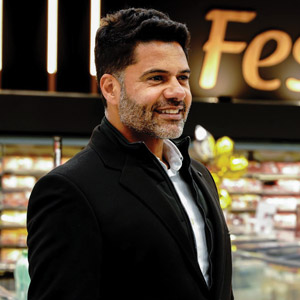THANK YOU FOR SUBSCRIBING

It's Time to Redefine Retail Entertainment Space
Jonathan Schwartz, VP of Real Estate and Business Development, IT’SUGAR


Jonathan Schwartz, VP of Real Estate and Business Development, IT’SUGAR
Jonathan Schwartz is a dynamic leader in real estate and development with an extensive career spanning over a decade. He currently serves as the Vice president of real estate and business development for IT’SUGAR, and is on a mission to transform the retail industry by innovating new methods to enhance customer experience.
What are the predominant challenges currently confronting the retail industry?
Two primary challenges are reshaping the retail industry today. First is the emergence of online shopping, which has wholly altered consumer behavior and necessitated physical retail spaces to provide compelling reasons for inperson visits. Recent developments indicate a shift toward creating communal outdoor areas and eventdriven experiences as a solution.
In this evolving landscape, companies like us are finding massive growth opportunities. We are synergizing well with the trending focus on entertainment, food, and beverage experiences, gaining a competitive edge in attracting footfall to physical locations.
The other challenge is the escalating construction costs. Our portfolio includes three different store sizes: 3,000, 5,000, and 15,000 square feet. Additionally, we operate five stores that span 30,000 square feet each, and a sixth flagship store is slated for inauguration by year’s end. To mitigate the impact of rising construction costs, we are developing a new, smaller store model, less than 3,000 square feet in size. This strategy aims to offset the financial burden of construction by reducing the overall square footage of our new outlets, especially in an inflationary economic environment.
What current trends are helping tackle these pain points and impacting the industry lately?
The infusion of entertainment into retail spaces is a dominant trend, driving considerable shifts in the industry. Many existing properties are undergoing repurposing to incorporate non-traditional, entertainment-centric spaces. This evolution is evident in the vacant big-box stores in malls and new lifestyle centers that designate areas specifically for communal gatherings and entertainment. The pivot toward food and beverage offerings also underscores this trend, as many retail spaces undergo conversion into dining establishments.
In parallel, the general retail sector is witnessing a perceptible tilt toward e-commerce. Apparel and accessory retailers are significantly expanding their online platforms, strategically limiting their brick-and-mortar presence to key markets. This allows them to maintain crucial touchpoints with customers while minimizing the overhead associated with physical stores.
IT’SUGAR is always at the top of these trends as it operates in a unique niche that straddles retail and entertainment. Although the business model relies on traditional retail metrics—chief among them being sales revenue—the brand’s raison d’être is entertainment. In doing so, the brand imbues the candy industry with a fresh perspective, augmented by interactive elements.
Could you discuss a recent project or initiative in which you have incorporated emerging trends in the retail industry? Could you briefly outline the strategies employed and the trends that were integrated into the project?
Key examples can be found in some of our 5,000-squarefoot stores as well as in all our flagship outlets. In these locations, we have introduced custom-fabricated sculptures and visual elements as thematic decor, adding another layer of immersion and engagement with our brand. This aligns with the current retail trend of creating immersive, experiential spaces to attract consumers.
Moreover, we’ve pioneered the first-ever candy department store concept, primarily in our flagship format. Here, we feature individualized shops dedicated to popular candy brands such as Jelly Belly, Swedish Fish, and Sour Patch Kids. This strategy allows us to curate and introduce new product lines that offer fans of these brands an entirely novel way to experience them.
The key to achieving this is to create dynamic retail environments that offer customers experiences they cannot replicate online. Assembling a collection of tenants committed to innovative activations can substantially elevate a retail center’s appeal
At the core of our approach is the desire to elevate the retail experience by seamlessly incorporating entertainment elements. We aim to meet and exceed customer expectations, offering them unprecedented ways to interact with the candies they’ve always loved. This strategy is not confined to our larger outlets; it is being integrated across our entire portfolio, even in smaller format stores, distinguishing us as a brand.
What advice could you offer to seasoned professionals and emerging talents in the retail industry?
For peers and newcomers in the retail industry, my core advice is to place an undivided focus on customer-centric entertainment. The objective is to meet and exceed customer expectations by providing them with memorable experiences. This emphasis holds across the retail spectrum, not just in the retail entertainment sectors.
The key to achieving this is to create dynamic retail environments that offer customers experiences they cannot replicate online. Assembling a collection of tenants committed to innovative activations can substantially elevate a retail center’s appeal. Adopting this mindset can act as a catalyst for those in the industry or entering it, accelerating the sector’s transformation toward more interactive and experience-driven models.
Weekly Brief
I agree We use cookies on this website to enhance your user experience. By clicking any link on this page you are giving your consent for us to set cookies. More info
Read Also













